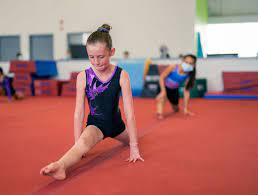Not every child dreams of the Olympics—and they don’t have to. Recreational gymnastics is one of the best ways for kids to stay active, grow in confidence, and develop physical literacy without the pressure of competition. Whether your child is new to sport or already loves to move, gymnastics offers the perfect mix of structure and fun.
In fact, gymnastics for kids provides lifelong benefits far beyond the mat. Let’s take a closer look at how recreational gymnastics supports children’s development, and why it’s one of the most popular entry points into sport across Australia.
What Is Recreational Gymnastics?
Recreational gymnastics is a non-competitive program that focuses on teaching children fundamental movement skills in a safe, supportive, and engaging environment. Classes are designed to be inclusive and age-appropriate, making them ideal for beginners and children who simply want to enjoy sport without competing.
Kids progress through levels at their own pace, learning how to:
- Balance
- Jump
- Roll
- Swing
- Land safely
Sessions typically include warm-ups, skill stations, games, and a cool-down. Some gyms also mix in strength and flexibility work in fun, playful ways.
The emphasis is always on participation, enjoyment, and growth.
1. Builds Physical Literacy
Physical literacy is the foundation of all sport and physical activity. It’s about more than just strength or coordination—it’s about knowing how your body moves and being confident using it.
Gymnastics helps children:
- Improve balance and spatial awareness
- Develop agility, strength, and flexibility
- Learn body control and coordination
- Move confidently across different surfaces and environments
This movement foundation transfers beautifully to other sports. Kids who develop early skills in gymnastics often go on to enjoy soccer, netball, athletics—or even something a little different like gymnastics for kids progressing into tape ball indoor cricket, where agility and hand-eye coordination matter just as much.
2. Enhances Focus and Discipline
Gymnastics teaches more than physical skills. It’s also a great tool for developing mental habits that help children thrive in school and everyday life.
During class, kids must:
- Listen carefully to instructions
- Follow safety rules
- Wait their turn
- Concentrate on precise movements
Even young children begin learning how to focus on a task, try again after a mistake, and stick with something that feels challenging. These habits build discipline, resilience, and problem-solving—skills that show up in the classroom, at home, and beyond.
3. Encourages Social Development
Gymnastics is an individual sport delivered in a group setting. This makes it ideal for developing social skills, especially for kids who may feel overwhelmed by competitive team games.
In every class, children:
- Work together during group warm-ups
- Encourage each other at stations
- Share equipment and space
- Celebrate each other’s small wins
These moments help build empathy, communication, and a sense of belonging. For many children, their gymnastics class is their first social circle outside school.
And if they eventually explore structured group games like tape ball indoor cricket, they’ll already have the foundation of teamwork and mutual respect.
4. Supports Emotional Wellbeing
Gymnastics encourages children to take small, safe risks—like trying a new roll or balancing on a beam for the first time. These experiences build confidence and a growth mindset.
Kids learn that:
- It’s okay to try and not get it right the first time
- Practice leads to progress
- Every child learns at their own pace
When children feel supported and celebrated for effort, they begin to internalise these messages. That confidence transfers into other parts of their lives—schoolwork, friendships, or even performing in front of a class.
And because movement itself helps reduce stress and boost mood, regular gymnastics participation also contributes to better mental health. According to Raising Children Network, gymnastics supports emotional regulation and self-esteem, particularly in early childhood.
5. Encourages Lifelong Activity
One of the biggest challenges for today’s parents is keeping kids active in a world filled with screens and sedentary habits. Recreational gymnastics helps instil the idea that movement is fun—not a chore.
The variety of activities means kids stay engaged:
- Climbing
- Rolling
- Jumping
- Swinging
- Crawling through obstacle courses
It’s playful, dynamic, and never the same twice. Many children who start with recreational gymnastics continue into other sports or physical activities later in life. It’s not about creating elite athletes—it’s about raising happy, healthy movers.
Even if they shift their interest later into group sports like tape ball indoor cricket, the habits built in gymnastics help them participate with confidence and control.
Real Story: How Gymnastics Helped Zoe Thrive
Zoe, 7, was a quiet child who often avoided physical games at school. Her parents enrolled her in a recreational gymnastics class hoping to build her confidence.
At first, she was shy and hesitant to try new skills. But week by week, she started to open up—first mastering a forward roll, then proudly balancing on a beam. The structured but pressure-free environment helped her blossom.
Six months later, Zoe not only looked stronger and more coordinated—she was happier, more social, and more willing to take on challenges at school. Her parents credit gymnastics with giving her a safe space to grow.
Is Recreational Gymnastics Right for Your Child?
If you’re wondering whether your child would enjoy recreational gymnastics, ask yourself:
- Do they like climbing, jumping, or exploring movement?
- Do they enjoy focused activities but not necessarily team competition?
- Would they benefit from building confidence and strength in a fun, social space?
If the answer is yes, then gymnastics might be the perfect fit.
Classes are available for all ages and skill levels, and most clubs offer trial sessions. Whether your child is five or twelve, it’s never too late—or too early—to start.
Final Thoughts: Movement That Matters
Recreational gymnastics for kids is more than an after-school activity. It’s a launchpad for physical health, emotional wellbeing, and social growth. It builds strong bodies and stronger minds—and, perhaps most importantly, it gives kids a chance to move with joy.
Whether your child sticks with gymnastics or uses it as a stepping stone into other sports like tape ball indoor cricket, the skills they learn will stick with them for life.
So if you’re looking for an activity that ticks every box—fun, fitness, focus, and friendship—recreational gymnastics might just be your answer.

